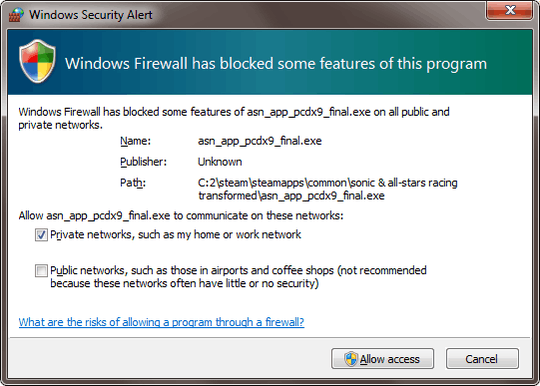14
2
I got this pop-up from the Windows firewall. What is "C:2\" in the path? The real path is D:\Steam\SteamApps\common\...

I tried cd /d C:2\ in cmd and got "The system cannot find the path specified."
I also tried cd C:2\ in Powershell and got "Set-Location : Cannot find path 'C:\2\' because it does not exist."
So how is "C:2\" a shortcut for "D:\"?
Update:
I tried searching for C:2 in the registry, as @Tyson suggested.
There are a lot of irrelevant search results when I search for C:2 in the registry with "Match whole string only" unchecked and no results with "Match whole string only" checked. Yet I found the key, it's in HKEY_LOCAL_MACHINE\SYSTEM\ControlSet001\services\SharedAccess\Parameters\FirewallPolicy\FirewallRules and its value is v2.10|Action=Allow|Active=TRUE|Dir=In|Protocol=17|Profile=Private|App=C:2\steam\steamapps\common\sonic & all-stars racing transformed\asn_app_pcdx9_final.exe|Name=asn_app_pcdx9_final.exe|Desc=asn_app_pcdx9_final.exe|Defer=User|. There is a rule for D:\Steam\SteamApps\common\Sonic & All-Stars Racing Transformed\ASN_App_PcDx9_Final.exe in Windows Firewall with Advanced Security > Inbound Rules. I also found a rule for Team Fortress 2, which is v2.10|Action=Allow|Active=TRUE|Dir=In|Protocol=6|Profile=Private|App=C:0\steam\steamapps\common\team fortress 2\hl2.exe|Name=hl2.exe|Desc=hl2.exe|Defer=User| in the registry and D:\Steam\SteamApps\common\Team Fortress 2\hl2.exe in the Windows firewall rule list. Other games installed in D:\Steam\... have D:\ both in the registry and Windows firewall rules. So it's probably how Steam makes aliases for drives other than C:\, but I'd like to know how it works, and why in one case it was C:2\, in another C:0\, and in the third one just D:\. I guess it's probably because it's an external HDD, and sometimes Steam couldn't find it the moment Windows woke up after sleep, so Steam assigned different aliases for it.
But what actually makes those aliases work? There are no folders called 2 or 0, it's just D:\Steam\...
3If I were to hazard a guess. Steam reported the incorrect location for some reason, my educated guess, C:2\ is steam specific syntax. – Ramhound – 2014-08-13T11:06:57.627
3Technically it's a valid path. It names the
2subdirectory on the current working dir of the C drive. Of course, if the CWD on the C drive doesn't have such a subdir, then you can't CD to it. – MSalters – 2014-08-13T11:49:00.927Does D: exist as a separate physical hard drive, or as a partition of the system drive? – Tyson – 2014-08-13T13:03:58.643
@Tyson: Separate physical drive. – HAL 9000 – 2014-08-13T16:00:52.917
2that shoots one of my theories... If your registry comfortable level allows, try searching the registry for
C:2\– Tyson – 2014-08-13T16:10:41.900@Tyson: I updated the post. – HAL 9000 – 2014-08-19T09:24:51.727
Does the firewall rule with that path even work? you could ask here http://steamcommunity.com/discussions/ (assuming that's the steam you're talking about).
– barlop – 2014-08-19T09:37:25.900This is not limited to Steam as I have seen it in other applications too. Happy that I found your question. This is quite difficult to search for. – signine – 2015-09-09T16:46:01.970
@MSalters Technically, the command prompt is the only program that even has a concept of working directory per drive. – user253751 – 2016-09-29T05:33:30.790